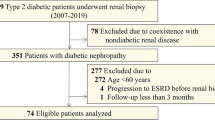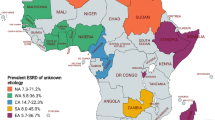Abstract
This study characterizes treatment and outcome trends of adolescent patients initiating renal replacement therapy in the USA from 1978 to 2002. This is a retrospective analysis of data from the US Renal Data System (USRDS) of incident end-stage renal disease (ESRD) patients, ages 12 years through 19 years, initiating renal replacement therapy between 1978 and 2002. Survival analyses were conducted from either the first date of kidney failure or date of transplantation until death or 31 December 2002. The ESRD incidence per million adolescents increased from 17.6 in 1978 to 26.0 in 1990, with no change in incidence in the ensuing 12 years. Incidence was slightly higher among males than females and was twice as great in black than in white populations. The major cause of ESRD was glomerulonephritis followed by cystic/congenital diseases and focal segmental glomerulosclerosis (FSGS). Incidence increased with age, from 13.0 per million for children aged 13 years to 32.6 per million for 19 year olds. Three-quarters of all adolescent patients received at least one transplant, and one-fifth of patients received two or more transplants. Ten percent of incident adolescent patients received a preemptive transplant. The 10-year survival rate was lowest in the 1978–1982 incident cohort (77.6%) and improved to approximately 80% for later cohorts. Survival was better for younger adolescents, transplant recipients, preemptive transplant recipients, males, Caucasian, and Asian patients. The primary mode of renal replacement therapy is transplantation in most adolescent ESRD patients. The 80% 10-year survival rate for adolescent-onset ESRD is very good when compared with adult-onset ESRD. However, this represents a 30-fold increase in mortality compared to the general US adolescent population.

Similar content being viewed by others
Explore related subjects
Discover the latest articles and news from researchers in related subjects, suggested using machine learning.References
National Institutes of Health (2003) US renal data system, USRDS 2003 annual data report: atlas of end-stage renal disease in the United States. In: National Institutes of Health (ed) National Institutes of Diabetes and Digestive and Kidney Diseases, Bethesda, MD
McDonald SP, Craig JC (2004) Long-term survival of children with end-stage renal disease. N Engl J Med 350:2654–2662
Talley L, Stablein DM (2005) North American pediatric renal transplant cooperative study: 2005 annual report. The EMMES Corporation, Rockville, MD, pp 1–266
Ardissino G, Dacco V, Testa S, Bonaudo R, Claris-Appiani A, Taioli E, Marra G, Edefonti A, Sereni F, Italkid Project (2003) Epidemiology of chronic renal failure in children: data from the ItalKid project. Pediatrics 111:e382–e387
Miklovicova D, Cornelissen M, Cransberg K, Groothoff JW, Dedik L, Schroder CH (2005) Etiology and epidemiology of end-stage renal disease in Dutch children 1987–2001. Pediatr Nephrol 20:1136–1142
Agodoa L (2002) Racial disparities in kidney health: the puzzle to solve. Am J Kidney Dis 40:1337–1339
(2005) USRDS 2004 annual data report. Am J Kidney Dis 45 Suppl 1:8–280
Groothoff JW, Gruppen MP, Offringa M, Hutten J, Lilien MR, Van De Kar NJ, Wolff ED, Davin JC, Heymans HS (2002) Mortality and causes of death of end-stage renal disease in children: a Dutch cohort study. Kidney Int 61:621–629
Arias M, Anderson RN, Hsiang-Ching K, Murphy SL, Kochanek KD (2003) Deaths: final data for 2001. In: Sanders TW (ed) US Department of Health and Human Services, Centers for Disease Control and Prevention, National Center for Health Statistics, National Vital Statistics System, Atlanta, pp 1–116
National Institute of Diabetes and Digestive and Kidney Diseases (2002) US Renal Data System, USRDS 2002 annual data report: atlas of end-stage renal disease in the United States. National Institutes of Health, Bethesda, MD
Wong CS, Hingorani S, Gillen DL, Sherrard DJ, Watkins SL, Brandt JR, Ball A, Stehman-Breen CO (2002) Hypoalbuminemia and risk of death in pediatric patients with end-stage renal disease. Kidney Int 61:630–637
Wong CS, Gipson DS, Gillen DL, Emerson S, Koepsell T, Sherrard DJ, Watkins SL, Stehman-Breen C (2000) Anthropometric measures and risk of death in children with end-stage renal disease. Am J Kidney Dis 36:811–819
Furth SL, Hwang W, Yang C, Neu AM, Fivush BA, Powe NR (2002) Growth failure, risk of hospitalization and death for children with end-stage renal disease. Pediatr Nephrol 17:450–455
Wolfe RA, Ashby VB, Milford EL, Ojo AO, Ettenger RE, Agodoa LY, Held PJ, Port FK (1999) Comparison of mortality in all patients on dialysis, patients on dialysis awaiting transplantation, and recipients of a first cadaveric transplant. N Engl J Med 341:1725–1730
Luque-Coqui M, Chartt R, Tercero G, Hernandez RA, Romero B, Morales F (2003) Self-esteem in Mexican pediatric patients on peritoneal dialysis and kidney transplantation. Nefrologia 23:145–149
Soliday E, Kool E, Lande MB (2001) Family environment, child behavior, and medical indicators in children with kidney disease. Child Psychiatry Hum Dev 31:279–295
Blowey DL, Hebert D, Arbus GS, Pool R, Korus M, Koren G (1997) Compliance with cyclosporine in adolescent renal transplant recipients. Pediatr Nephrol 11:547–551
Wolff G, Strecker K, Vester U, Latta K, Ehrich JH (1998) Non-compliance following renal transplantation in children and adolescents. Pediatr Nephrol 12:703–708
Furth SL, Garg PP, Neu AM, Hwang W, Fivush BA, Powe NR (2000) Racial differences in access to the kidney transplant waiting list for children and adolescents with end-stage renal disease. Pediatrics 106:756–761
Eggers PW (1995) Racial differences in access to kidney transplantation. Health Care Finance Rev 17:89–103
Benfield MR, McDonald RA, Bartosh S, Ho PL, Harmon W (2003) Changing trends in pediatric transplantation: 2001 Annual Report of the North American Pediatric Renal Transplant Cooperative Study. Pediatr Transplant 7:321–335
Roberts JP, Wolfe RA, Bragg-Gresham JL, Rush SH, Wynn JJ, Distant DA, Ashby VB, Held PJ, Port FK (2004) Effect of changing the priority for HLA matching on the rates and outcomes of kidney transplantation in minority groups. N Engl J Med 350:545–551
Brouhard BH, Donaldson LA, Lawry KW, McGowan KR, Drotar D, Davis I, Rose S, Cohn RA, Tejani A (2000) Cognitive functioning in children on dialysis and post-transplantation. Pediatr Transplant 4:261–267
Groothoff JW, Grootenhuis M, Dommerholt A, Gruppen MP, Offringa M, Heymans HS (2002) Impaired cognition and schooling in adults with end stage renal disease since childhood. Arch Dis Child 87:380–385
Rasbury WC, Fennell RS, Fennell EB, Morris MK (1986) Cognitive functioning in children with end stage renal disease pre- and post-dialysis session. Int J Pediatr Nephrol 7:45–50
Qvist E, Pihko H, Fagerudd P, Valanne L, Lamminranta S, Karikoski J, Sainio K, Ronnholm K, Jalanko H, Holmberg C (2002) Neurodevelopmental outcome in high-risk patients after renal transplantation in early childhood. Pediatr Transplant 6:53–62
Brouhard BH, Donaldson LA, Lawry KW, McGowan KR, Drotar D, Davis I, Rose S, Cohn RA, Tejani A (2000) Cognitive functioning in children on dialysis and post-transplantation. Pediatr Transplant 4:261–267
Gipson DS, Wetherington CE, Duquette PJ, Hooper SR (2004) The nervous system and chronic kidney disease in children. Pediatr Nephrol 19:832–839
Gipson DS, Hooper SR, Wetherington CE, Duquette PJ, Stellwagen K (2003) Memory function in pediatric chronic renal failure: preliminary findings. J Am Soc Nephrol 14:538A (abstract)
Olsson CA, Walsh B, Toumbourou JW, Bowes G (1997) Chronic illness peer support. Aust Fam Physician 26:500–501
Fielding D, Brownbridge G (1999) Factors related to psychosocial adjustment in children with end-stage renal failure. Pediatr Nephrol 13:766–770
Ehrich JH, Rizzoni G, Broyer M, Brunner FP, Brynger H, Fassbinder W, Geerlings W, Selwood NH, Tufveson G, Wing AJ (1992) Rehabilitation of young adults during renal replacement therapy in Europe. 2. Schooling, employment, and social situation. Nephrol Dial Transplant 7:579–586
Reynolds JM, Morton MJ, Garralda ME, Postlethwaite RJ, Goh D (1993) Psychosocial adjustment of adult survivors of a paediatric dialysis and transplant programme. Arch Dis Child 68:104–110
Bartosh SM, Leverson G, Robillard D, Sollinger HW (2003) Long-term outcomes in pediatric renal transplant recipients who survive in adulthood. Transplantation 76:1195–1200
Acknowledgment
The authors acknowledge and appreciate the editorial assistance of C. Jean Brown in their preparation of this manuscript.
Author information
Authors and Affiliations
Corresponding author
Rights and permissions
About this article
Cite this article
Ferris, M.E., Gipson, D.S., Kimmel, P.L. et al. Trends in treatment and outcomes of survival of adolescents initiating end-stage renal disease care in the United States of America. Pediatr Nephrol 21, 1020–1026 (2006). https://doi.org/10.1007/s00467-006-0059-9
Received:
Revised:
Accepted:
Published:
Issue Date:
DOI: https://doi.org/10.1007/s00467-006-0059-9




